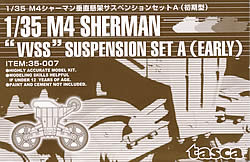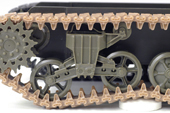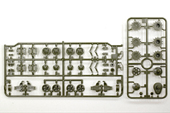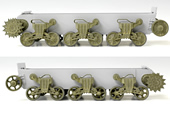|
 Tasca Tasca
#35007
This
set presents the later war T2C-2 intermediate raised roller pattern
vertical volute spring suspension. According to Pete Harlem in The
Modeler's Guide to the Sherman, this type of bogie was used
extensively on U.S. tanks from 1943 onward.
The
strong point of this set is that you can create a functionally articulating
suspension, which is most desirable if you are placing your AFV
on uneven terrain. Of course, this works best if you also use individual
track links as opposed to rubber band tracks, so be aware at the
outset that you're going to have a pretty work-intensive project
ahead of you. Tasca thoughtfully provides different back plates
to attach the bogies to Tamiya, Italeri, or DML hulls. A new pair
of final drive covers with axles is included to replace those that
come with the Tamiya and Italeri kits. The bogies include casting
serial numbers and the horizontal casting mark across the middle
section of the front surface, features that varied from one manufacturer
to another. The three bolts at the bottom of the gudgeon blocks
(both front and rear) as well as the bolts securing the rubbing
blocks to the levers are crisply rendered.
 You
also have a choice between an elliptical production skid style and
the more familiar late war final version. The intermediate style
is hard to identify in period photos, but was likely seen on 1943
production tanks. You
also have a choice between an elliptical production skid style and
the more familiar late war final version. The intermediate style
is hard to identify in period photos, but was likely seen on 1943
production tanks.
On
the down side, it's curious that, with such attention to detail,
Tasca did not reproduce the four bolts that secured the roller arm
to the bogie bracket. Nor did they add the open bolt holes on the
side of the bracket opposite the roller arm. This is likely a limitation
of the injection molding process, but a scale diagram to use for
positioning and drilling the holes would have been a very helpful
inclusion. As it is, the instructions are primarily in Japanese,
which does little to clarify why one would choose the available
options (such as the skids or the two different axle caps for the
rear idler). The diagrams are helpful, although it did take me some
time to see that the "T," "I," and "D"
amid the accompanying Japanese characters in headers bars identified
the particular Tamiya, Italeri, or DML hull illustrations.
 Assembly
of this kit begins with determining your style of idlers, either
open spoked or solid spoked (and by extension, which type of these
two styles you will use as road wheels). You have three options
of sprockets: fancy smooth, revised fancy smooth, and solid. One
nice aspect of the sprockets is that Tasca has cast them so the
connection of each piece to the sprue is made through three thin
slivers of plastic on the back side of the sprockets, rather than
connecting directly to the tips as is often done. There is a small
sprue of two sizes of poly rings, the larger size for use with the
solid spoke idler and all three styles of sprockets. There is no
indication as to what one should do with the smaller poly rings. Assembly
of this kit begins with determining your style of idlers, either
open spoked or solid spoked (and by extension, which type of these
two styles you will use as road wheels). You have three options
of sprockets: fancy smooth, revised fancy smooth, and solid. One
nice aspect of the sprockets is that Tasca has cast them so the
connection of each piece to the sprue is made through three thin
slivers of plastic on the back side of the sprockets, rather than
connecting directly to the tips as is often done. There is a small
sprue of two sizes of poly rings, the larger size for use with the
solid spoke idler and all three styles of sprockets. There is no
indication as to what one should do with the smaller poly rings.
Both styles of road wheels have the grease plugs on the hubs. The
solid spoke wheels have separate back sides that are inserted to
complete the wheel, a welcome improvement over the open back Tamiya
wheels. There are mold seams and some unevenness on the outside
surfaces on the wheels and idlers that must be cleaned up.
 Tasca
includes on the sprues the miniscule rivets that secure the rubber
tire to the rim on the road wheels. If you desire this level of
detail, you need to carefully shave these rivet heads from the sprue
and fasten them to the inner face of the rim. There are 12 rivets
per wheel, times twelve wheels (only enough to do the outward facing
sides of the wheels). If you want this detail without the eyestrain,
Tiger Model Designs has a nice resin set of wheels that has the
rivets molded onto the rims. Tasca
includes on the sprues the miniscule rivets that secure the rubber
tire to the rim on the road wheels. If you desire this level of
detail, you need to carefully shave these rivet heads from the sprue
and fasten them to the inner face of the rim. There are 12 rivets
per wheel, times twelve wheels (only enough to do the outward facing
sides of the wheels). If you want this detail without the eyestrain,
Tiger Model Designs has a nice resin set of wheels that has the
rivets molded onto the rims.
For
this review I constructed a couple of the bogie units, each of which
is comprised of fourteen pieces, including a pair of wheels and
three pieces of rubber pad that you measure and cut from a small
foam sheet. These pieces are stacked atop one another and sandwiched
into one half of the bogie. The vertical volute springs rock against
the pads, which compress as the road wheels moved over the terrain.
Once the other half of the bogie is in place, the separately installed
levers slide on the rubbing block, presumably just like a real suspension.
Of course, care must be taken in assembly so as not to get any glue
on moveable parts and defeat the whole purpose of this product.
You'll
want to clean up the joint seams between the two bogie halves before
installing your choice of skids, which are cast more thinly than
the usual original kit parts. Unfortunately, the more common long
skid is missing one of its four retaining bolts.
When
attaching the sprockets and idlers to your tank's hull, you will
need to alter the axle lengths to varying degrees, depending on
the hull you are using. For the Tamiya hull, you'll need to cut
out 0.5mm from the center of the rear axle and narrow the axle's
diameter to 2.4mm, and remove 0.8mm from the tip of the front axle.
The DML hull requires that you shave the diameter of the rear axle
down to 2.4mm, and add a small length of 2.4mm diameter rod to the
front axle. Only the Italeri hull escapes such surgery. I did not
venture into this part of the project for my review since I haven't
determined what tank I'll use with this set.
Overall,
this is a pretty good set, nicely detailed and crisply molded. It's
puzzling that, with the level of detail Tasca provides, key bolts
are missing. At least they could have included them on the sprues,
as they would likely be used much more frequently than the rivets
for the road wheels. This fact and the less-than-helpful instructions
keep this set from being a five-star product.
Ultimately,
whether this kit is worth the high price (at approximately $33,
it's as much or more than the cost of most complete Sherman kits)
depends on how badly you need a fully articulated suspension. Consequently,
when you take into account the assembly of link-to-link tracks to
take full advantage of the Tasca suspension and the necessary modifications
to the source kit, this product is geared more towards the experienced
or advanced modeler.
-tss-
|












